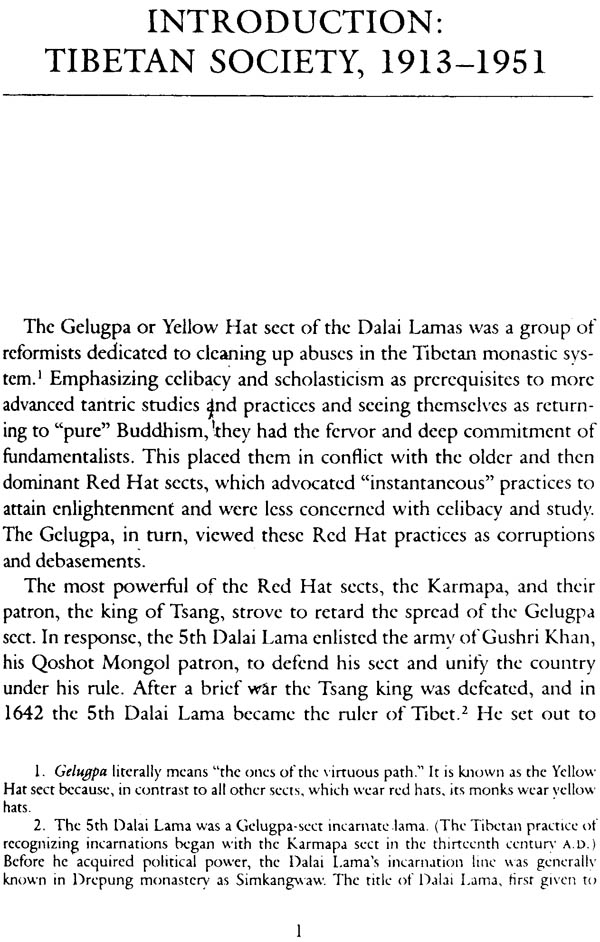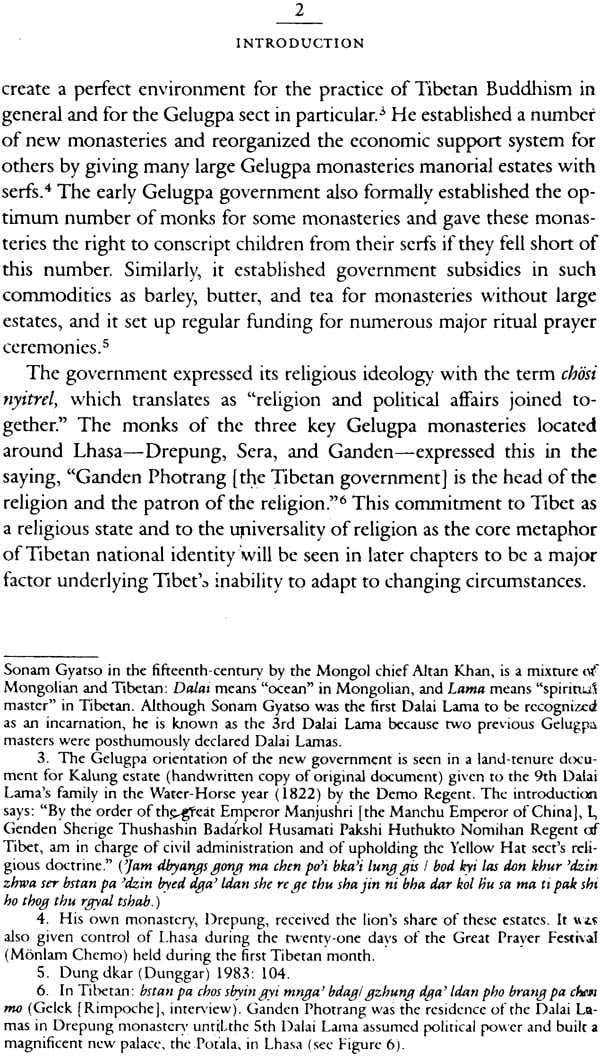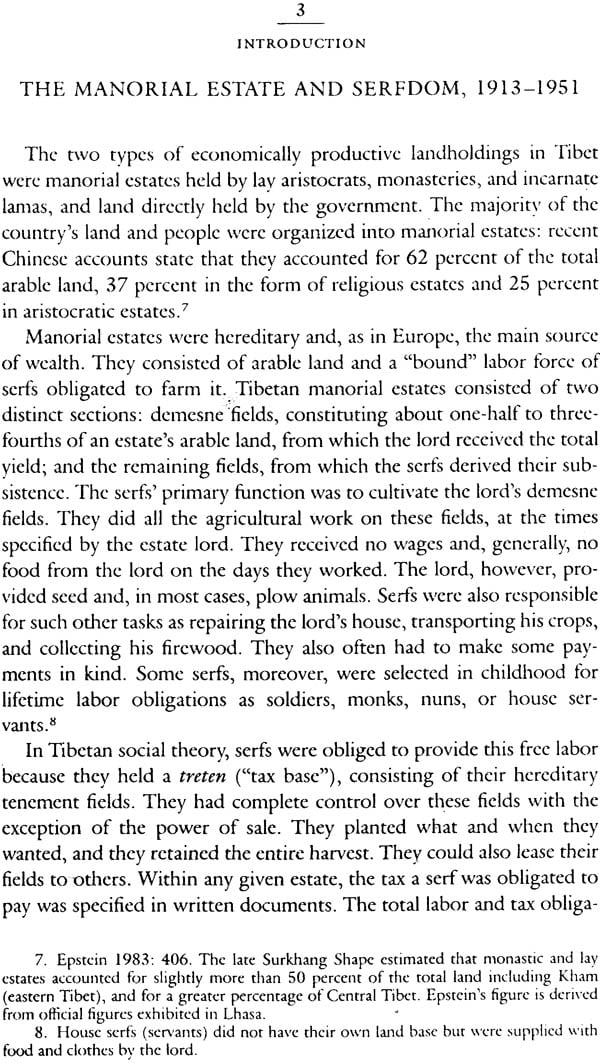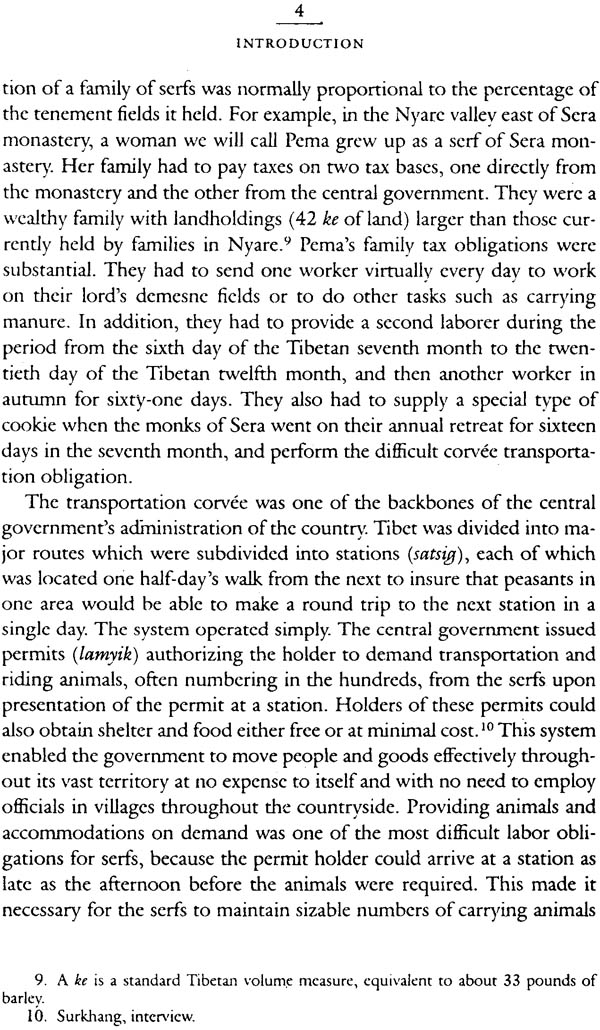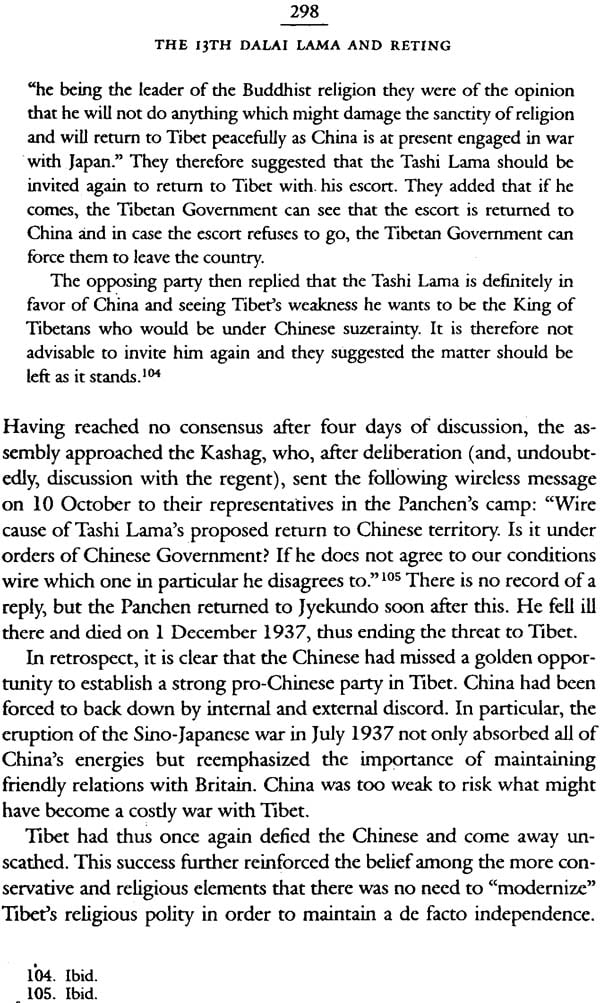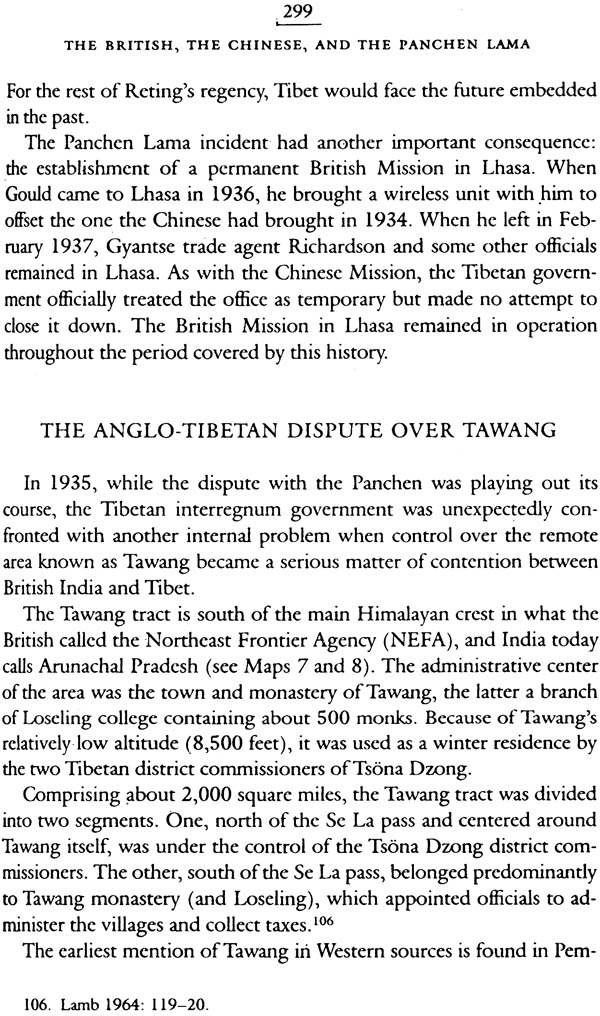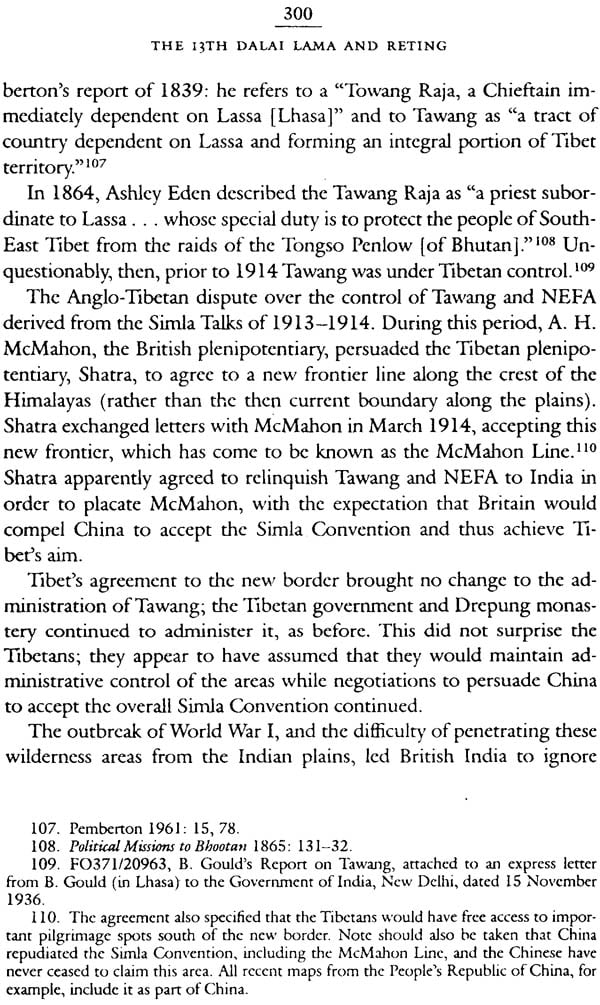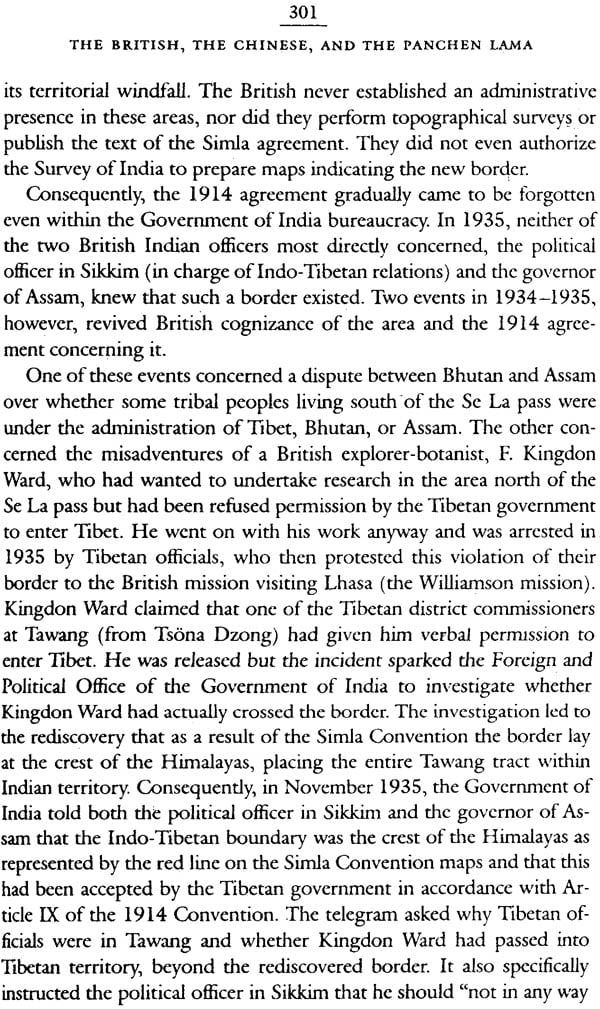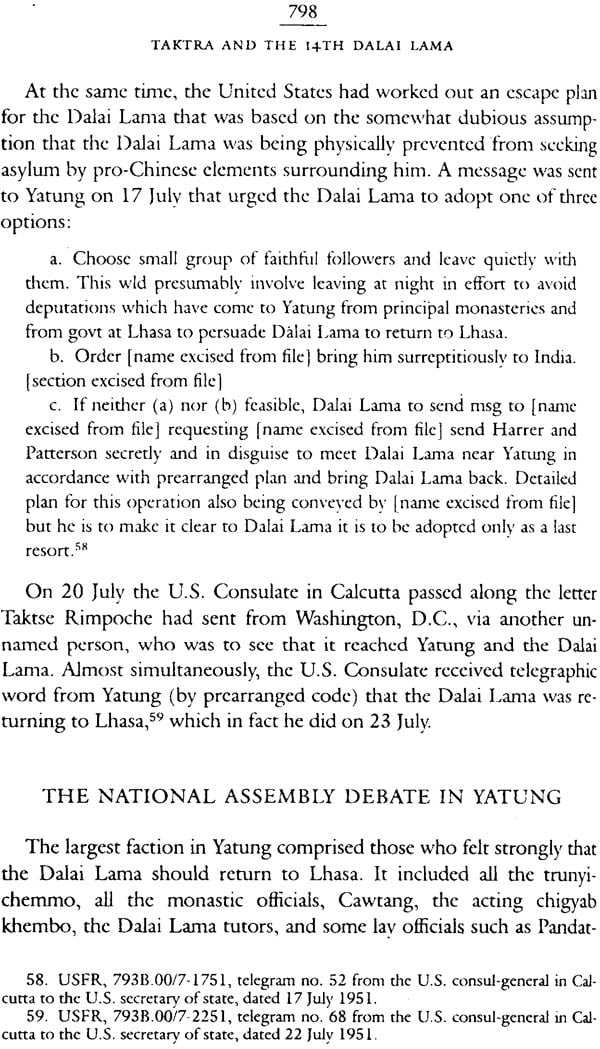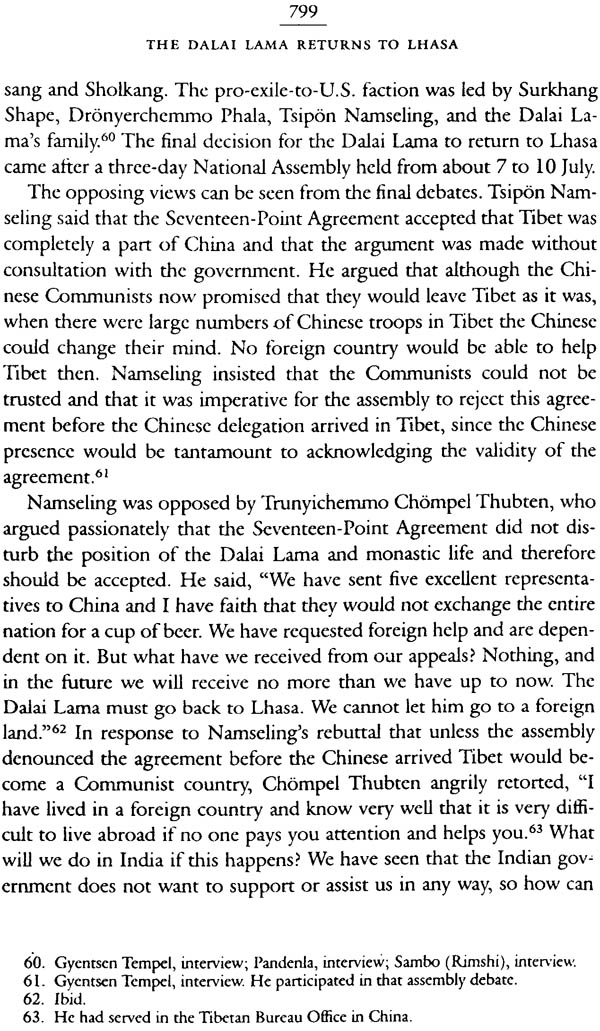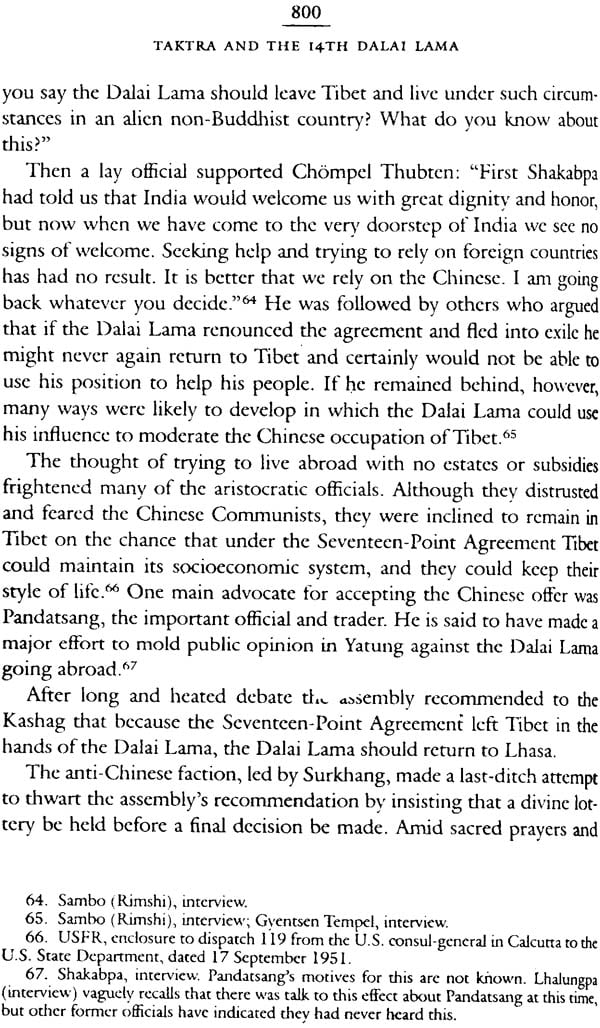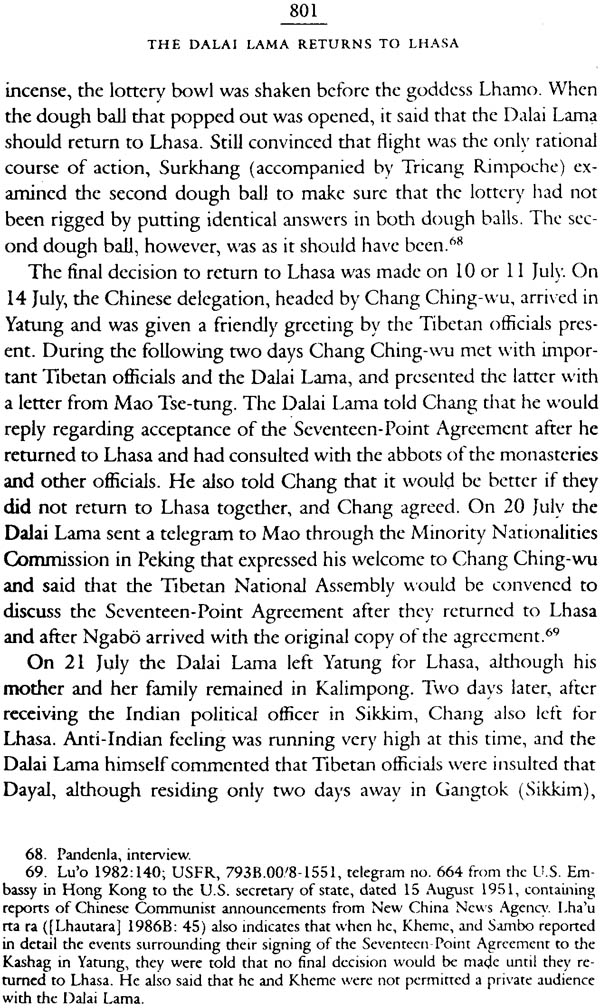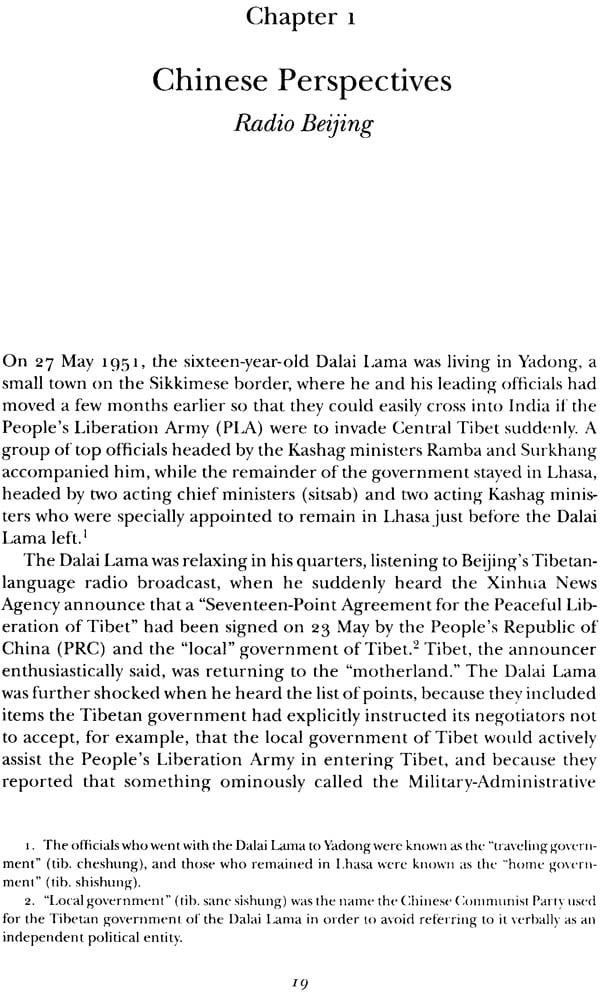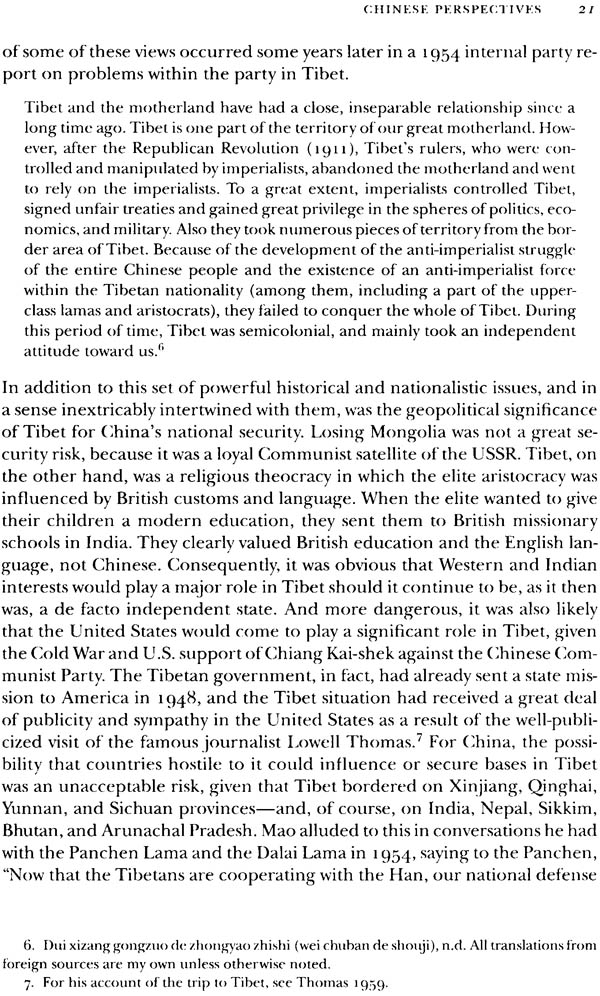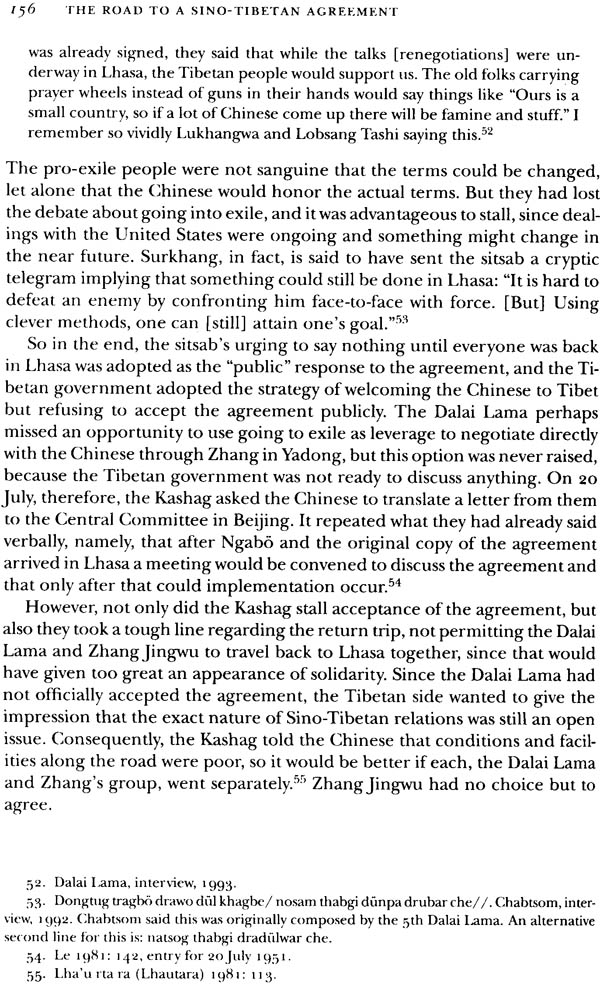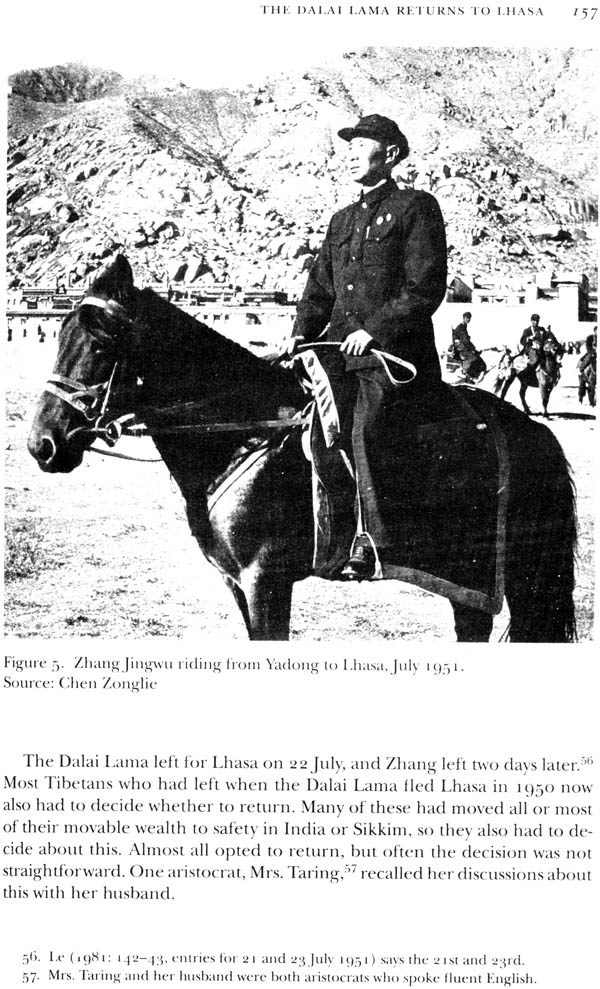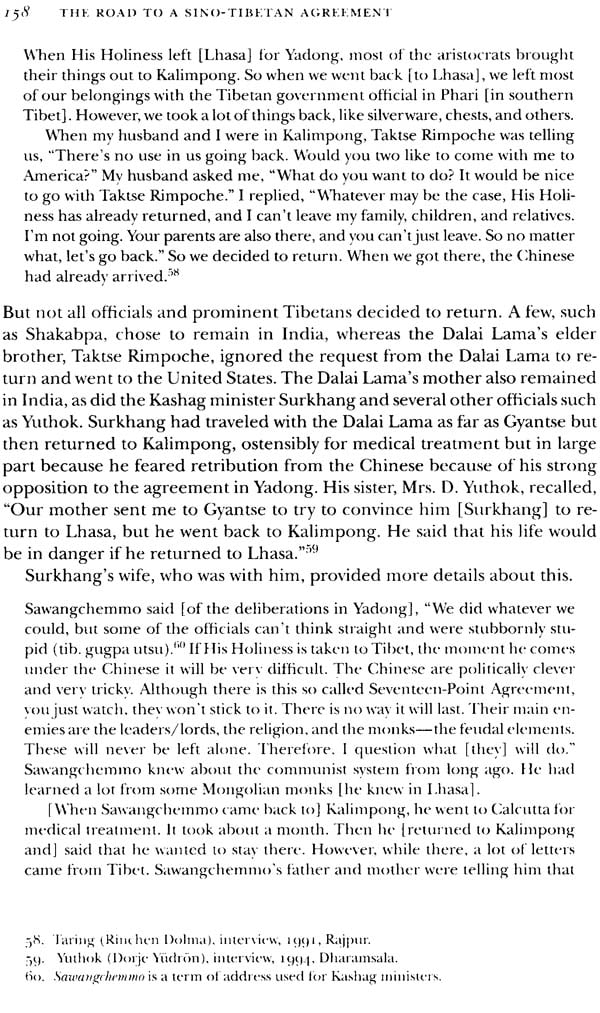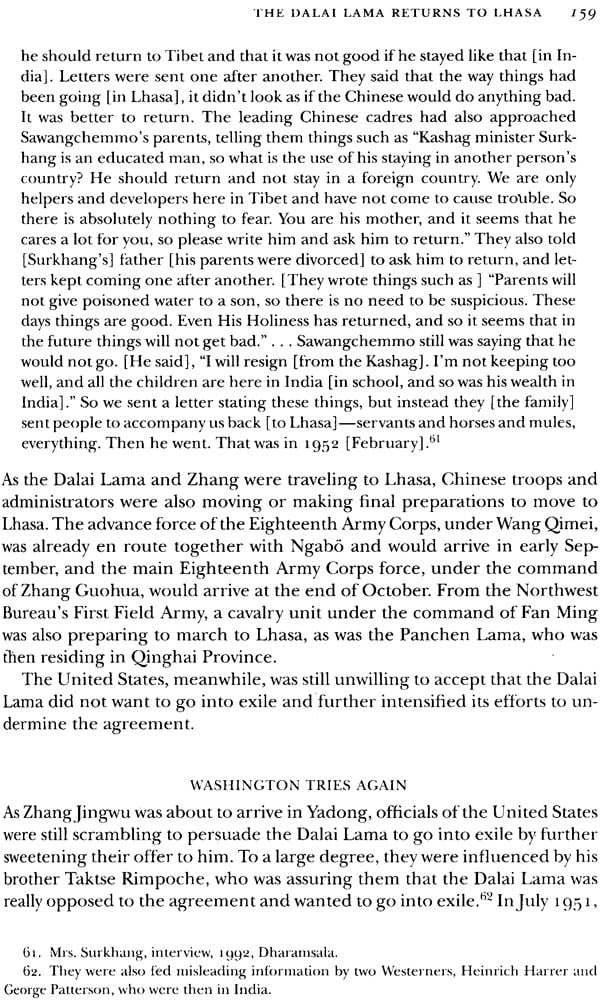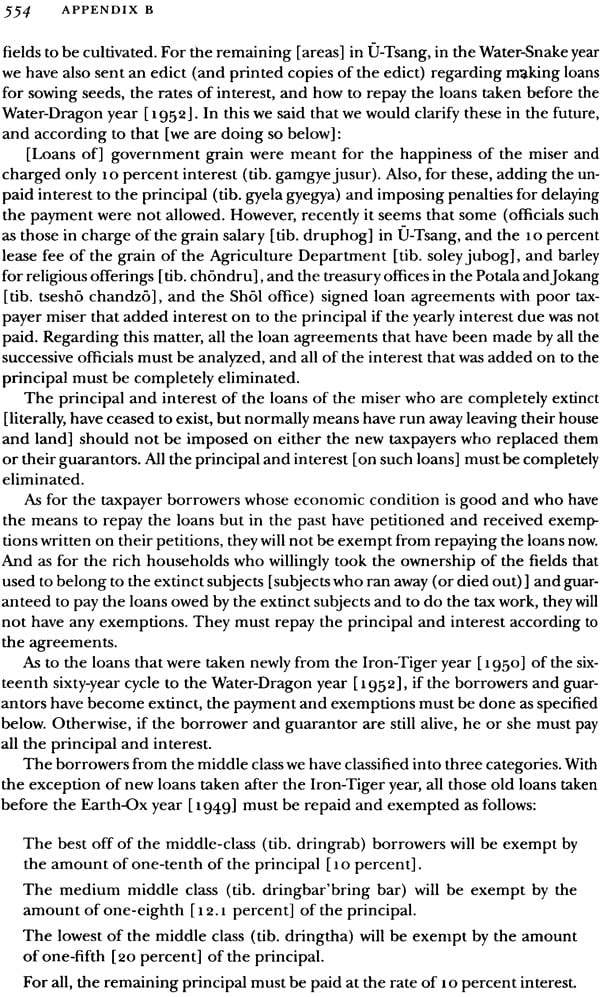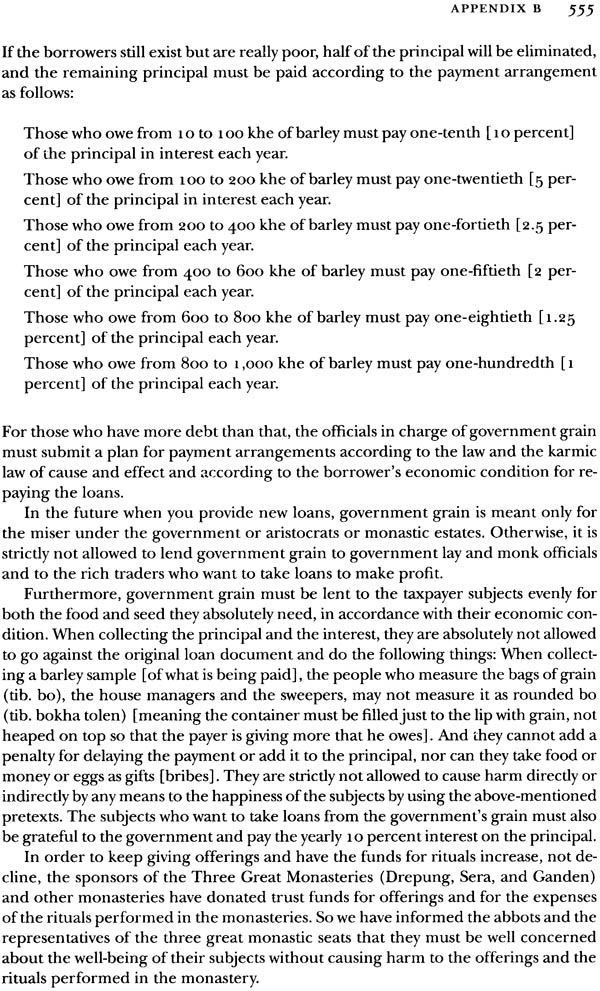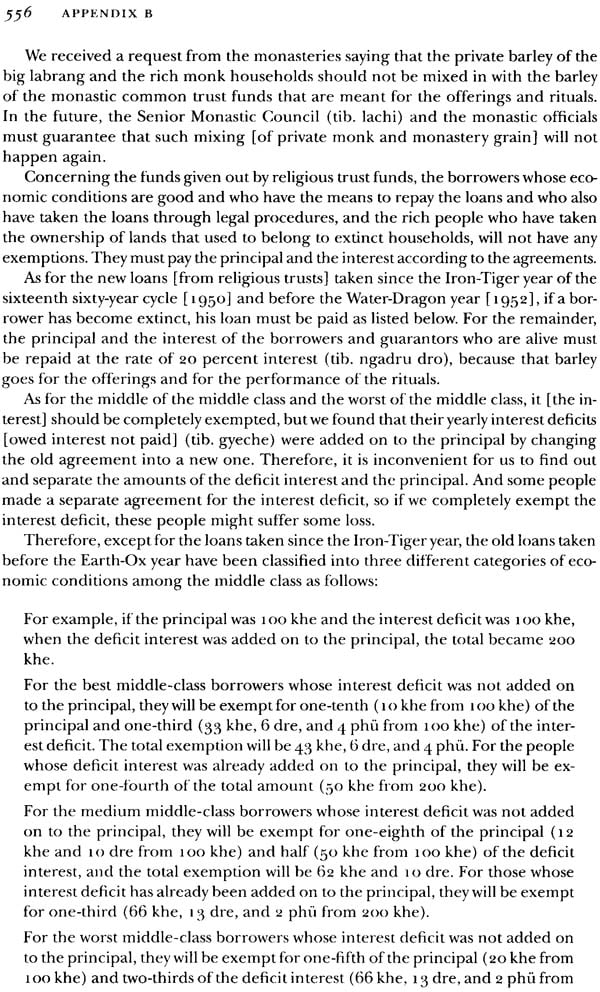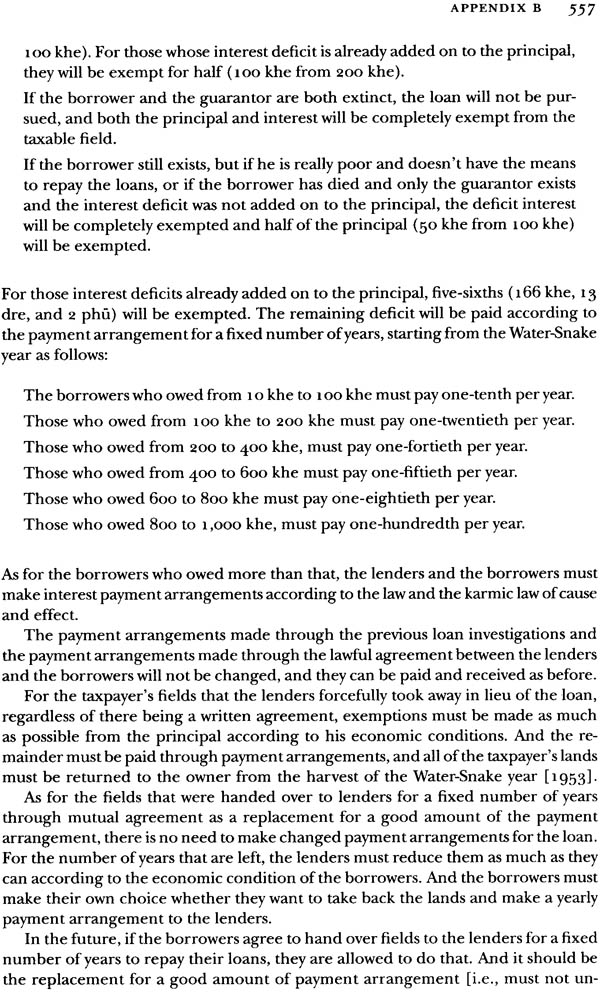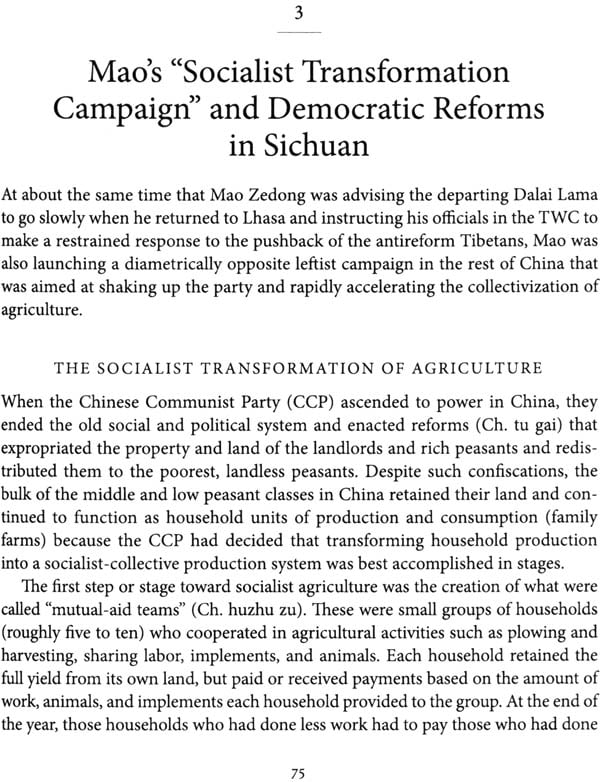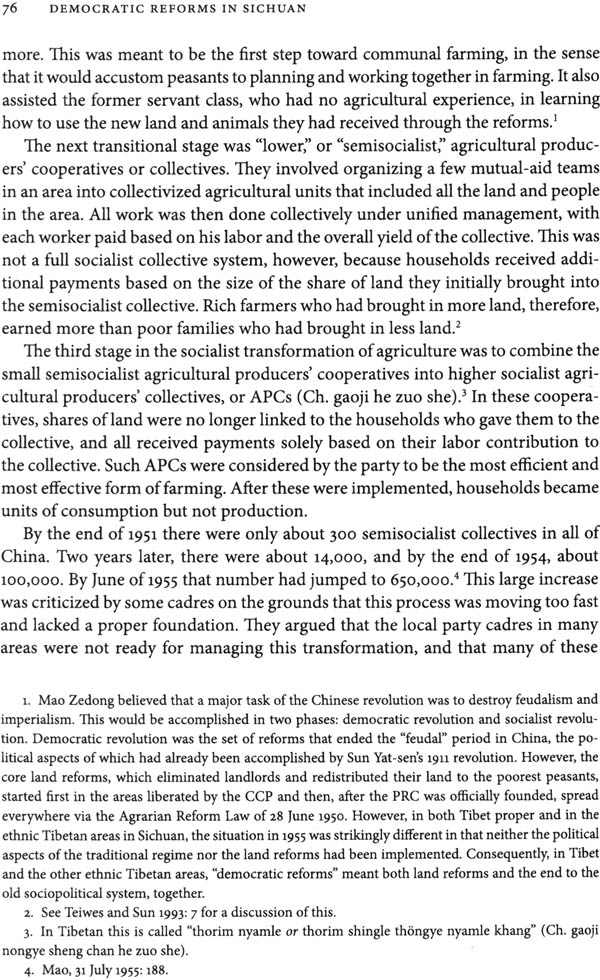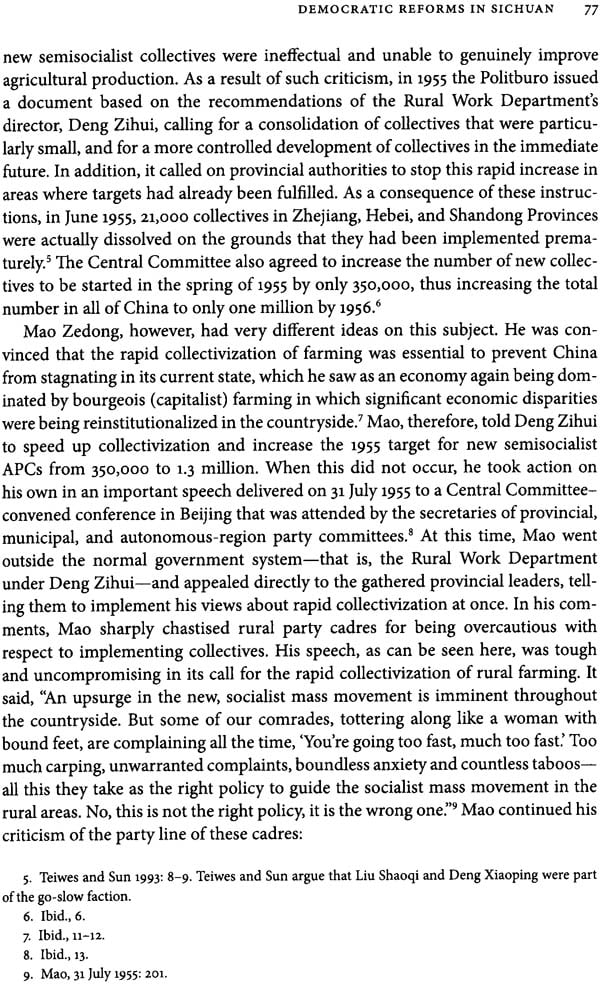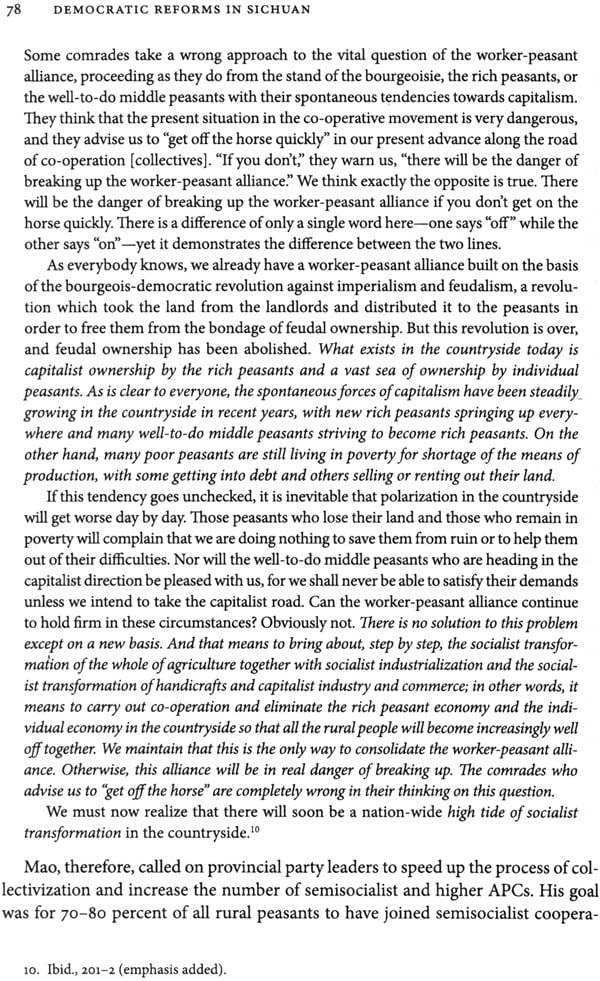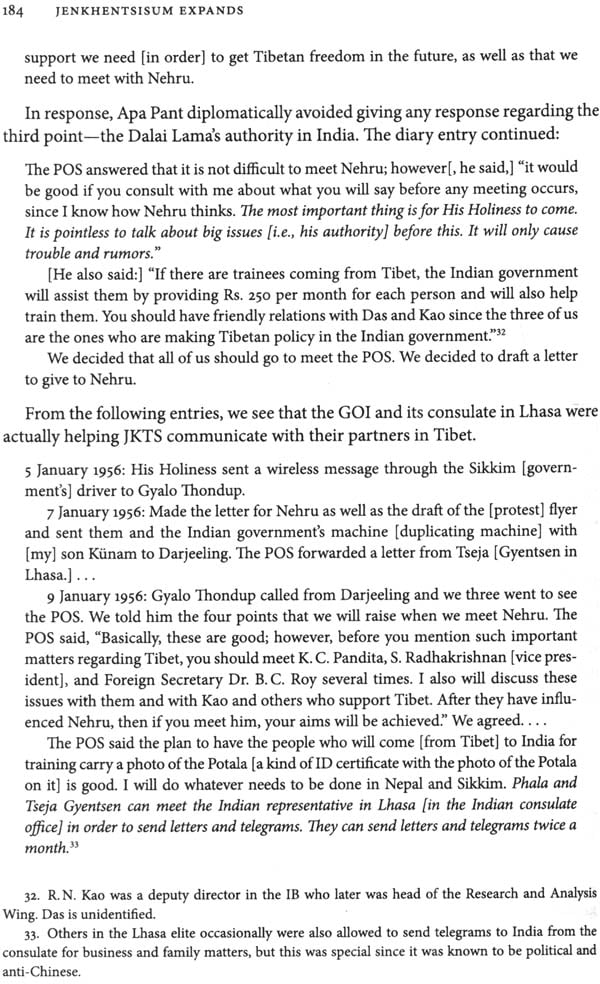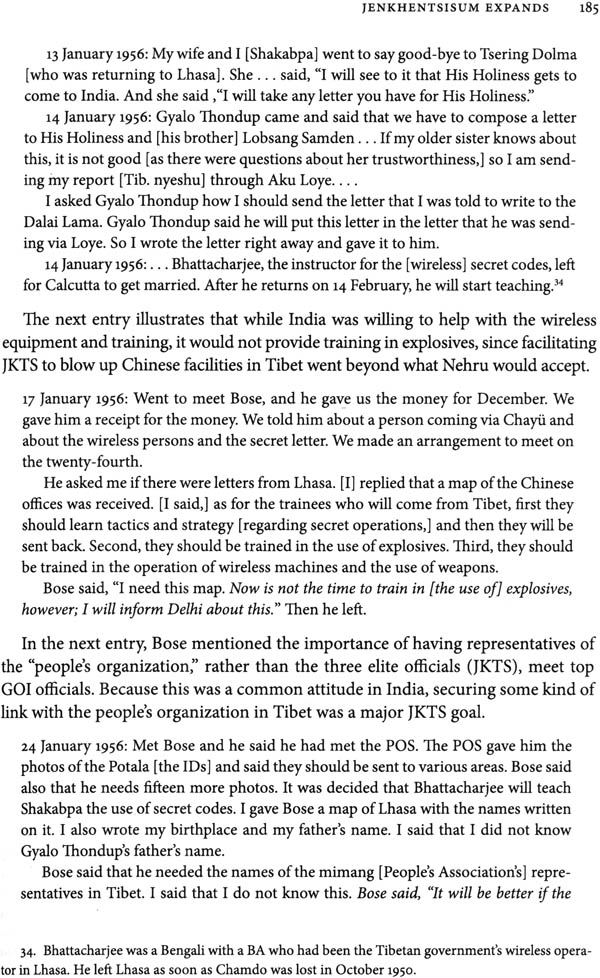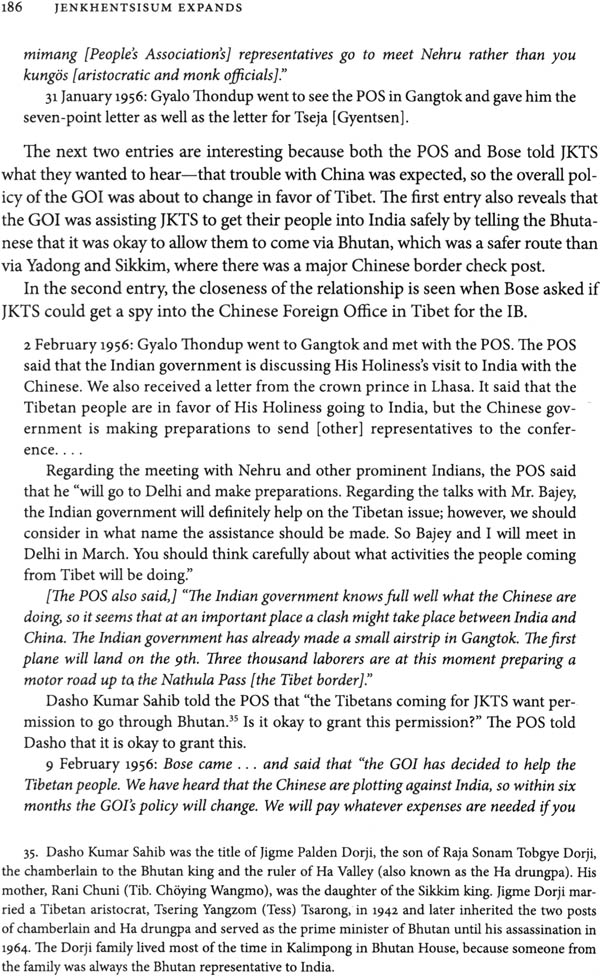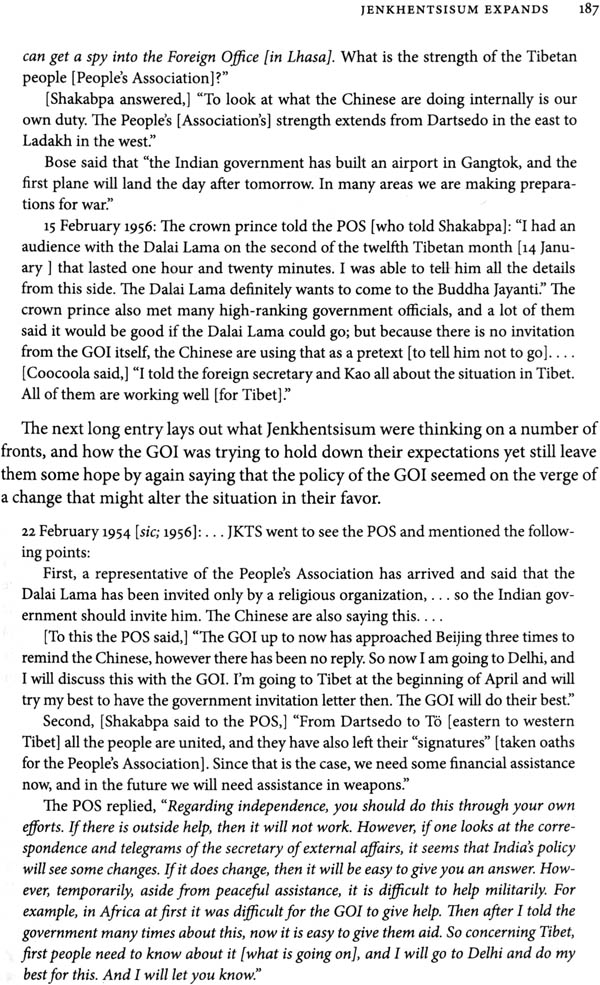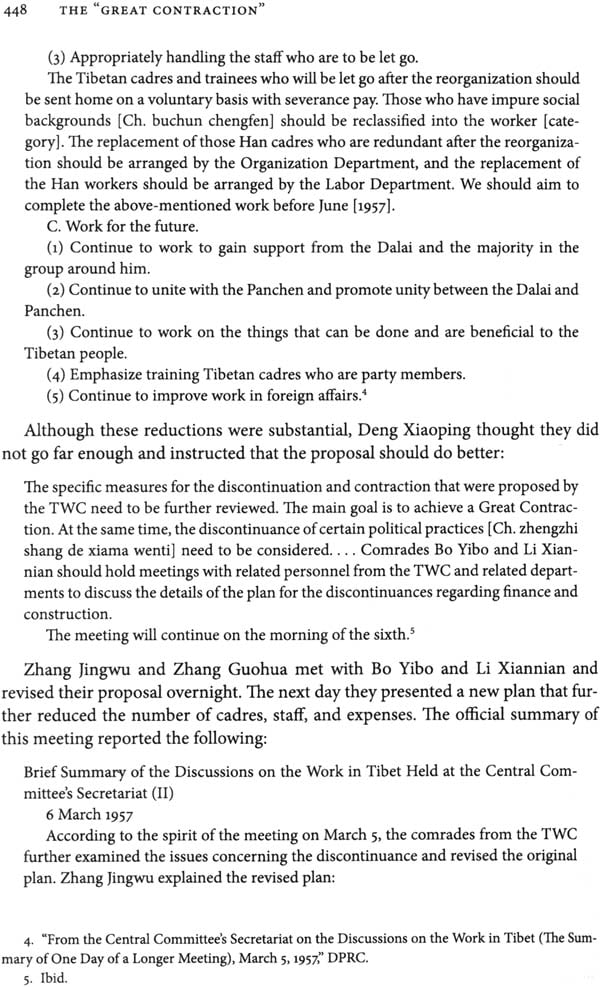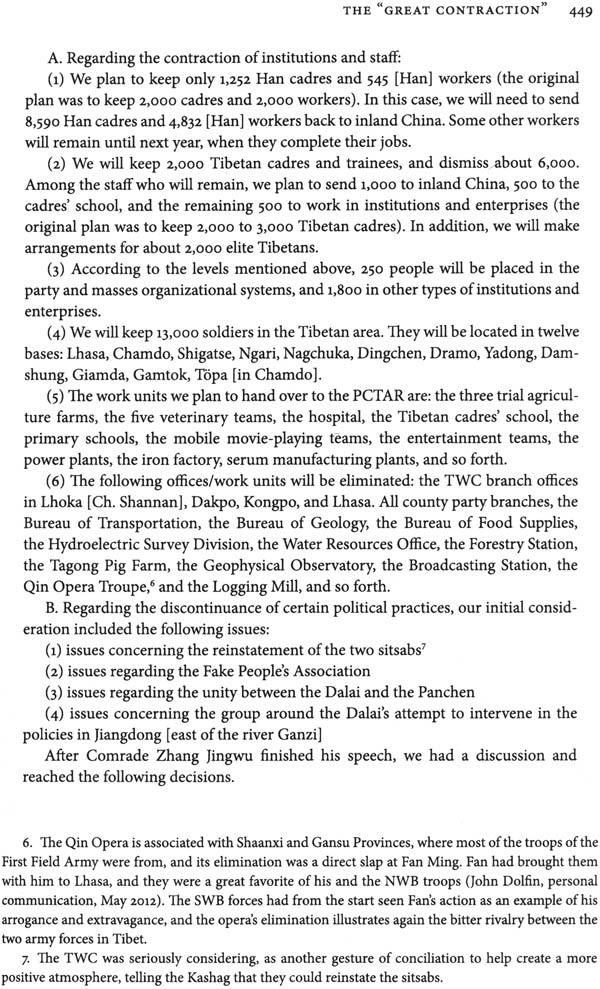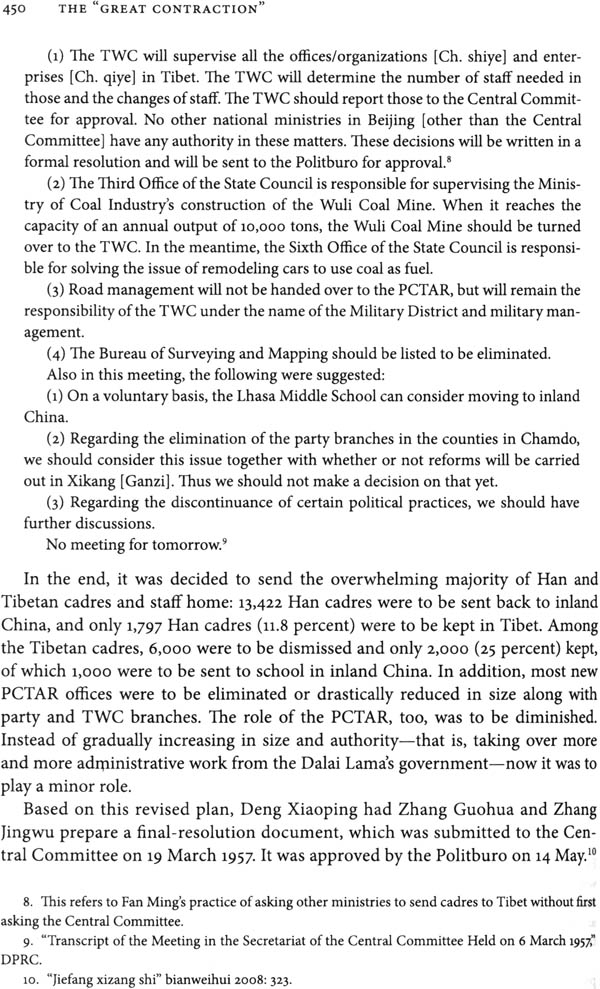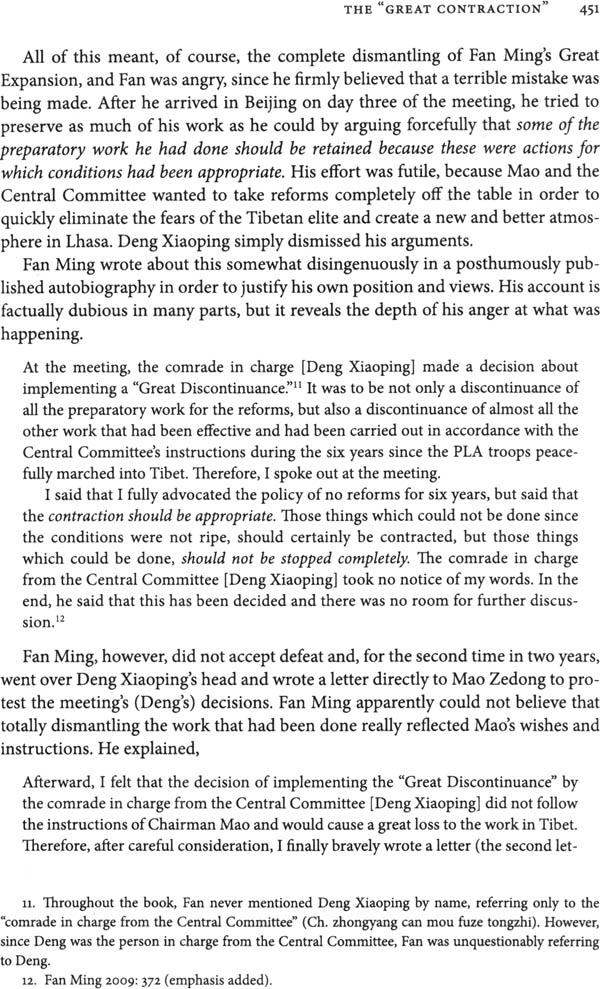
A History of Modern Tibet (Set of 3 Volumes)
Book Specification
| Item Code: | NAJ901 |
| Author: | Melvyn C. Goldstein |
| Publisher: | Dev Publishers and Distributors |
| Language: | English |
| Edition: | 2014 |
| Pages: | 1622 (100 B/W Illustrations and 21 Maps) |
| Cover: | Paperback |
| Other Details | 9.0 inch x 6.0 inch |
| Weight | 2.60 kg |
Book Description
Volume I : The Demise of The Lamaist State (1913-1951)
Volume II : The Calm Before the Storm (1951-1955)
Volume III : The Storm Clouds Descend (1955-1957)
Volume I
About the Book
The "Tibetan Question," the nature of Tibet's political status vis-a-vis China, has been the subject of often bitterly competing views while the facts of the issue have not been fully accessible to interested observers. While one faction has argued that Tibet was, in the main, historically independent until it was conquered by the Chinese Communists in 1951 and incorporated into the new Chinese state, the other faction views Tibet as a traditional part of China that split away at the instigation of the British after the fall of the Manchu Dynasty and was later dutifully reunited with "New China" in 1951. In contrast, this comprehensive study of modern Tibetan history presents a detailed, non-partisan account of the demise of the Lamaist state.
Drawing on a wealth of British, American, and Indian diplomatic records, first-hand-historical accounts written by Tibetan participants; and extensive interviews with former Tibetan officials, monastic leaders, soldiers, and traders, Goldsrein meticulously examines what happened and why. He balances the traditional focus on international relations with an innovative emphasis on the intricate web of internal affairs and events that produced the fall of Tibet. Scholars and students of Asian history will find this work an invaluable resource and interested readers will appreciate the clear explanation of highly polemicized, and often confusing, historical events.
About the Author
Melvvn C. Goldstein is John Revnolds Harkness Professor in Anthropology, Codirector of the Center for Research on Tibet at Case Westernn Reserve University, and a member of the National Academy of Sciences. He is the author of many books on Tibet, including volumes 2 and 3 of A History of Modern Tibet, also published by Dev Publishers & Distributors.
Contents
| | List of Illustrations | xi |
| | Acknowledgments | xv |
| | Explanation of Romanization and Abbreviations | xvii |
| | Preface | xix |
| | Introduction: Tibetan Society, 1913-1951 | |
| | I | |
| | THE ERA OF THE 13TH DALAI LAMA AND RETING, 1913-1941 | |
| 1. | The Early Years of the 11th Dalai Lama | 41 |
| 2. | Tibet and the New Republic in China | 65 |
| 3. | The Dalai Lama, the Army, and the Monastic Segment | 89 |
| 4. | The Death of the 13th Dalai Lama | 139 |
| 5. | The Fall of Kumbela | 146 |
| 6. | In Search of a New Tibet: Lungshar's Reform Party | 186 |
| 7. | The Mission of General Huang Mu-sung | 213 |
| 8. | The British, the Chinese, and the Panchen Lama | 252 |
| 9. | Reting Takes Control, Then Resigns | 310 |
| 10. | Conclusion to Part One: The Reting Years | 364 |
| | II | |
| | THE ERA OF TAKTRA AND THE 14TH DALAI LAMA, 1941-1951 | |
| 11. | The Early Years of the Taktra Regency: 1941-1943 | 369 |
| 12. | Change and Confrontation in the Twilight of World War II | 405 |
| 13. | The Seeds of Rebellion | 427 |
| 14. | The Reting Conspiracy | 464 |
| 15. | The Victory Congratulations Mission, 1945-1946 | 522 |
| 16. | Further Attempts at International Visibility | 560 |
| 17. | TIbet after the Fall of the Kuomintang | 611 |
| 18. | The People's Liberation Army Invades | 638 |
| 19. | After the Fall of Chamdo | 698 |
| 20. | Tibet Capitulates: The Seventeen-Point Agreement | 737 |
| 21. | The Dalai Lama Returns to Lhasa | 773 |
| | Conclusion: The Demise of the Lamaist State | 815 |
| | Postscript | 825 |
| | Appendix A. Anglo-Chinese Convention of 1906 | 827 |
| | Appendix B. Angle-Russian Convention of 1907 | 829 |
| | Appendix C. The Simla Agreements of 1914 | 832 |
| | Glossary of Tibetan Terms | 843 |
| | References | 845 |
| | Correct Tibetan Spellings | 855 |
| | Index | 883 |
Volume II
Preface
This volume is part 1 of a two-part study of the 1951-59 era, which continues the story of modern Tibet begun in my A History of Modem Tibet, 1913-1951: The Demise of the Lamaist State (University of California Press, 1989). The narrative in this volume starts with the events leading to the Tibetan government's signing of the Seventeen-Point Agreement for the Liberation of Tibet in May 1951.1 In that agreement, Tibet grudgingly accepted Chinese sovereignty for the first time in its history, and Chinese Communist troops and officials quickly entered Lhasa. For Tibetans, a new, albeit unwanted, era began. How both sides dealt with this new situation is the focus of this study.
This book ends four years later in mid: June 1955, when the Dalai Lama returned from a year-long trip to China, enthusiastic about starting to modernize Tibet as an integral part of the People's Republic of China. At this juncture, Tibet was calm, religious and secular institutions were intact, and innovations such as primary schools were increasing. This was the high point in Sino-Tibetan cooperation and rapprochement.
However, within months of the Dalai Lama's return, Sino-Tibetan relations began to spiral downhill, ending four years later with the uprising of 1959 and the flight of the Dalai Lama into exile. Part 2 of this history will examine the second four-year period, from the Dalai Lama's return to Lhasa in 1955 to the uprising in 1959. The history of Tibet in the 1950s has not been studied in depth. Despite being a critical transitional period between the traditional society and the new socialist society that was implemented after the failed uprising in 1959. In general, the period has been viewed simplistically as a confrontation in which Tibetans faced Chinese Communists in a showdown doomed to fail because the Chinese were intent on destroying Tibet. As with most stereotypic generalizations, there is some truth to this view, but new primary data have revealed that neither the Chinese nor the Tibetan side was as homogeneous as previously thought. Not only did each side have significant internal factions representing conflicting points of views, but these internal factions allied themselves with factions on the opposite side, creating a far more complex situation than had been previously realized. The current study, therefore, attempts to examine this period, taking into account the complexity that existed on both the Tibetan and Chinese sides with the aim of presenting a detailed and balanced history of this important era of modern Tibet.
SOURCES AND METHODS
A multiple methodology was employed for this study, utilizing five sources of data: (1) primary materials, including government records, unpublished letters, and diaries from individual Tibetans; (2) oral history data from interviews conducted specially for this project with Tibetan, Chinese, and American participants; (3) firsthand "memoir" accounts written by former Tibetan, Chinese, European, and Indian officials (in Tibetan, Chinese, and English); (4) restricted circulation (eh. neibu) books from China that include citations from documents and interview data; (5) newspapers, books, and academic monographs and articles, some of which quote primary political documents.
Primary Materials: Government Records and Documents
Although a study such as this would normally be rooted in an analysis of government documents, access to such materials was difficult to secure. The Tibet Autonomous Region (and other parts of China) refused to give access to any documents in its extensive archives, as did the Government of India.
The United States government provided limited access to its records. Some State Department documents were available in the National Archives and via the United States Foreign Relations publication series, but many more documents, presumably important, were withheld from the archives and not released despite my "freedom of information" requests and appeals. The CIA and the National Security Agency released virtually no documents, stating that to do so would be detrimental to the United States' national interests. As absurd as this may sound fifty years after these events occurred, it was part of the reality I encountered while conducting this research.
The British national archives (the Public Records Office) contained some materials on this period, but this corpus was limited in quality and quantity, particularly for the years after 1953, when the Government of India stopped sending London copies of its Lhasa Mission's monthly report to Delhi.
Nevertheless, a series of very important Chinese documents was obtained from India (Dui xizang gongzuo de zhongyao zhishi [wei chuban de shouji] [Important Instructions on Work in Tibet]), where they had been taken at the end of the Cultural Revolution. Other important Chinese documents were cited in secondary books on the period and in compilations of official documents published in China, for example, a compendium of Mao's statements on Tibet. Similarly, a number of important documents held by the Tibetan govern men t in exile and by the Library of Tibet Works and Archives in Dharamsala were made available to me, as were important primary materials written by the famous Tibetan official Tsipon Shakabpa.
Taken together, these primary materials are an invaluable window to the history of the 1950s. There are, to be sure, still gaps and confusions whose clarification will have to wait until the remaining archival materials are released, particularly those in the Tibetan archives in China, but the corpus of primary materials that were available for this history are important and substantial. When possible, I have included full texts of relevant documents so that readers can see the full content of the documents and not have to depend on only one or two-sentence summaries.
Oral Historical Data
Oral history-the collection of primary historical data by interviewing eyewitnesses concerning some period or event-can provide invaluable information when government records are not readily available or as a supplement to such records. Oral historical research, however, is not without problems. Memory is often selective, participants' accounts are sometimes self-serving, and current political issues can affect the quality and quantity of the accounts. Consequently, such accounts need to be evaluated carefully in terms of the background of the subject and checked against other interviews and archival sources when available. I tried diligently to do this.
Funding from the National Endowment for the Humanities (R0-22 251-91 and RO-22754-94), enabled interviews to be conducted with over one hundred individuals in China, India, Nepal, England, and North America. The subjects included important Tibetans such as the Dalai Lama, Ngabo, Lhalu, and Takla (Phimtso Tashi), and important Chinese officials such as Li Zuoming and Fan Ming. Parts of interviews conducted for my previous history of modern Tibet (with funding from the National Endowment for the Humanities, RO-20261-82, and RO-20886-85) were also utilized. Several former members of the CIA who were involved with Tibet were interviewed as well.
Permission was also kindly granted to utilize transcripts of important interviews conducted in Dharamsala by the Tibetan Government-in-Exile's Publicity Office and by the Library of Tibet Works and Archives, some of which were from key Tibetan officials who had died by the time this project was started.
Most of our interviews were conducted between 1991 and 1995. In general, interviews involved multiple visits, almost all of which were recorded on audio tape. Follow-up visits were often made to clarify information in the initial interviews or to cover events not discussed initially. On many occasions, six to ten hours of interviews were conducted with a single person. The English transcripts of these interviews compose a corpus of over six thousand pages. Dr. Paljor Tsarong conducted most of the interviews in India either alone or with me, and I did the interviews in England, Hong Kong, Tibet, and other parts of China. Both Dr. Tsarong and I conducted interviews in the United States.
When contradictory versions of important events were collected, these were evaluated in accordance with (1) understanding of how the traditional system operated; (2) other accounts; (3) the source of the subject's information (hearsay or firsthand); (4) the relationship of the subject to the event for example, whether he was a relative or ally of the actors in the event-and (5) the subject's reputation for duplicity or honesty. On many important issues a decision had to be made regarding which version to accept, and I spent a great deal of time trying to clarify issues by re-interviewing and conducting interviews with new individuals. Although alternative explanations of incidents are sometimes presented, usually in footnotes, it was not always possible or desirable to do so.
All these interviews are currently being compiled for inclusion in the Tibet Oral History Archive and are being prepared with support from Henry Luce Foundation by the Center for Research on Tibet (Case Western Reserve University). They eventually will be housed permanently in the Asian Division of the Library of Congress and will be available to scholars and students on the Internet as a Web archive.
Restricted Circulation (Neibu) Publications from China
I was fortunate to obtain several important sources of data from China that were published on a restricted circulation basis, that is, not available to the general public. One of these is the official Zhonggong xizang dangshi dashiji (Chronology of Major Events of the Chinese Communist Party in Tibet) in several versions. It is organized as a chronological diary of even is and includes citations from documents, telegrams, and so forth. In addition, I was able to utilize a number of important books published in China that were also either neibu or had been published briefly but then withdrawn from circulation.
Eyewitness and Other mitten Accounts
An important source of information on the period derived from the substantial number of published accounts on the period written by participants. These "memoir" materials were published in China and India in both Tibetan and Chinese languages. They range from books such as those written by Alo Chondze, Shenkawa, Kundeling, and Namseling to articles in journals/ magazines and collected volumes, such as the invaluable series Bod kyi lo rgyus rig gnas dpyad gzhi'i rgyu cha bdam bsgrigs pa (Selected Materials on the History and Culture of Tibet) and the Gsar brje'i dran tho (Revolutionary Memoirs).
Newspapers, Books, and Articles
Published magazine articles from China during this period were utilized via the Survey of Mainland China Press series. Newspapers from Western countries and India were also consulted, as was the Tibetan-language newspaper published in Kalimpong called Yul phyogs so so'i gsar gyur me long (the Mirror of World News, better known in English simply as the Tibetan Mirror). Books published in China and the West were, of course, also consulted. Many of these included some primary interview data or, on the Chinese side, government records otherwise unavailable to me. A set of the Bod Ijongs nyin re tshags pa (Tibet Daily Newspaper) from the 1950S was also utilized.
Consequently, despite the lack of full access to official governmental records, the primary information on which this study is based provides a level of detail and understanding not heretofore attainable.
CITATION CONVENTIONS
Throughout the book, square brackets are used for comments or clarifications that I have added. For example, in the following quotation:
[If this occurs] we absolutely will fight back militarily and contend for victory according to the principle of "reasonable, moderate and beneficial to us" (ch. youli youli youjie).
In this quotation, I added "[If this occurs]" for clarification: By contrast, the words in parentheses "(eh. youli youli youjie)" represent the original Chinese phrase that was translated as "reasonable, moderate and beneficial to us."
Contents
| | LIST OF ILLUSTRATIOS | ix |
| | PREFACE | Xi |
| | ACKNOWLEDGMENTS | Xvii |
| | NOTE ON ROMANIZATION | Xix |
| | LIST OF ABBREVIATIONS | Xxi |
| | GLOSSARY OF KEY PERSONS AND TERMS | Xxiii |
| | Introduction: Tibetan Society on the Eve of Incorporation into China | 1 |
| | PART ONE. THE ROAD TO A SINO-TIBETAN AGREEMENT | |
| 1. | Chinese Perspectives: Radio Beijing | 19 |
| 2. | Tibetan Perspectives: Contacts with the Chinese Communists | 41 |
| 3. | Tibet Appeals to the United Nations | 59 |
| 4. | Negotiations with Beijing | 82 |
| 5. | The United States Intervenes | 114 |
| 6. | The Dalai Lama Returns to Lhasa | 118 |
| | PART TWO. THE FIRST TWO YEARS: CONFRONTATION AND ADJUSTMENT | |
| 7. | Initial Contacts and Strategies | 169 |
| 8. | The Advance PLA Force Arrives in Lhasa | 206 |
| 9. | The Food Crisis | 244 |
| 10. | The Panchen Lama and the People's Liberation Army | 265 |
| 11. | First Steps toward Implementing the Seventeen-Point Agreement | 301 |
| 12. | The Tibetan People's Association | 314 |
| 13. | Turning to the Dalai Lama and Removing the Sitsab | 341 |
| 14. | The Return of the Panchen Lama | 385 |
| | PART THREE COOPERATION AND CHANGE | |
| 15. | Winds of Change | 399 |
| 16. | Conflict within the Communist Party in Tibet | 422 |
| 17. | Tibet's First Steps toward Socioeconomic Reform | 454 |
| 18. | Events in India | 464 |
| 19. | The Dalai Lama Goes to Beijing | 478 |
| 20. | The Dalai Lama in Beijing | 491 |
| 21. | The Return to Lhasa | 523 |
| 22. | Conclusions | 541 |
| | APPENDIX A. LOBSANG SAMDEN'S 1952 LETTER TO TSIPON SHAKABPA | 551 |
| | APPENDIX B. KASHAG'S 1953 EDICT REFORMI G DEBTS I TIBET | 553 |
| | APPENDIX C. AGREEMENT OF THE SECRET RESISTANCE | |
| | ORGANIZATION IN INDIA, 1954 | 561 |
| | APPENDIX D. LIST OF CORRECT TIBETAN SPELLINGS | 565 |
| | REFERENCES | 583 |
| | INDEX | 605 |
Volume III
About the Book
It is not possible to fully understand contemporary relations between China and the Dalai Lama without understanding what happened in the '950s. This third volume in Melvyn C. Goldstein's series on the history of modern Tibet examines the critical years of 1955 through 1957·During this period, the Preparatory Committee for the Tibet Autonomous Region was inaugurated in Lhasa, and a major Tibetan uprising occurred in Sichuan Province. jenkhentsisum, a Tibetan anti-communist emigre group, emerged as an important player with secret links to the Indian Intelligence Bureau, the Dalai Lama's lord chamberlain, the United States, and Taiwan. And in Tibet, fan Ming, till' acting head of the Chinese Communist Party's office' in Lhasa. launched the "Great Expansion," which recruited many thousands of Han cadres to Lhasa in preparation for democratic reforms, only to be stopped decisively by Mao Zedong's "Great Contraction," which sent them hack to China and ended talk of reforms in Tibet for the foreseeable future.
In this third volume, Goldstein draws on never-before-seen Chinese government documents, published and unpublished memoirs and diaries, and invaluable indepth interviews with important Chinese and Tibetan participants-including the Dalai Lama-to offer a new level of insight into the events and principal players of the time. Goldstein corrects factual errors and misleading stereotypes and uncovers information on the period to reveal a nuanced portrait of Sino-Tibetan relations that goes far beyond anything previously imagined.
Preface
My first exposure to the intricacies of modern Tibetan history occurred in 1964 while I was a PhD student in anthropology and Tibetan studies at the University of Washington. The university's Far East and Russian Institute invited Wangchen Gelek Surkhang, the famous kalon (Kashag minister) in the traditional Tibetan government, to campus for a year to participate in its Inner Asia Project, and he ended up living with me for that year. Although I was officially in the Anthropology Department, I had received my BA and MA degrees in history from the University of Michigan and was then immersed in trying to understand modern Tibetan society and history, since my dissertation project was going to be a reconstruction of the Tibetan government and socioeconomic system through interviews with Tibetan refugees in India. Consequently, I took Surkhang's visit as an opportunity to clarify the many things I had been puzzling over concerning Tibetan history and society.
It was an amazing year. Typically, we would finish dinner and then retire to the living room for a cup of tea and conversation about modern historical events and figures and whatever else Kalon Surkhang felt like discussing. Surkhang, who had an amazing, almost photographic memory for detail, would regale me with accounts of the great events and people in modern Tibetan history, such as Reting Rinpoche, Lungshar, Kunphela, Tsarong Dzasa, Trimon, Kapshoba, and Khyungram. In retrospect, it was somewhat analogous to a student studying the Vietnam era having a yearlong independent studies course with Henry Kissinger.
It did not take long for me to realize that a different level of analysis than currently existed in the classic historical studies such as Hugh Richardson's Tibet and Its History was needed to meaningfully understand modern Tibetan history, and I made a commitment to myself to undertake to write such a history as soon as I received my PhD in anthropology and got settled into academia.
All of that took much longer than anticipated, and it was not until 1980 that I was able to free up the time to make a concerted effort to collect the primary data that existed in British and U.S. archives and conduct extensive oral history interviews with former officials. My initial plan to write a new, more detailed and nuanced single-volume history of modern Tibet has turned into a four-volume modern history project, two of which are completed, with this volume being number three.
From the start, I divided "modern Tibetan history" into three periods. The first extended from 1913 to 1951 and was the period during which Tibet operated as a de facto independent polity ruled by the Dalai Lama and a "bureaucracy" comprised of monk and aristocratic officials. That first period was the subject of volume I, A History of Modern Tibet, 1913-1951: The Demise of the Lamaist State.
The second period was the era between the end of the de facto independent polity in 1951 and the end of the Tibetan government and estate system after the failed Tibetan uprising in 1959. The first half of that period, 1951-1955, was covered in volume 2, A History of Modern Tibet: The Calm before the Storm, 1951-1955.
I originally planned for the current volume-volume 3-tO cover the rest of the period (i.e., 1955-1959), but after I started work, it became apparent that there was too much new material from both Chinese and Tibetan sources to compress it into a single volume, so I decided to divide the period into two. Volume 3, therefore, begins with the return of the Dalai Lama from his four-month visit to China in June 1955 and ends in the spring of 1957, when two major events occurred.
On the Tibetan side, despite being constantly pressured to enter exile to head an emigre organization, the Dalai Lama decided it was best to return, and he arrived in Lhasa on 1 April 1957.
On the Chinese side, at about the same time, Mao Zedong also made a major decision not to implement reforms in Tibet and to dismantle Fan Ming's "Great Expansion" -through which Fan was preparing to start democratic reforms in Tibet-and replace it with his own "Great Contraction.”
What happened after this, and why, will be the subject of the next and last volume.
WRITING CONTEMPORARY TIBETAN HISTORY
The late Tsipon Shakabpa, one of the great figures in modern Tibetan history and politics, once told me not to write anything that would hurt the "Tibetan cause:' I understood his view, but in the end, when it came time to write up my research on Tibetan history, as an American academic I could not do that-any more than I could have ignored Abu Ghraib or Guantanamo while writing a history of the United States in the Middle East because it would hurt the reputation and relations of the United States in the Arab world.
My approach in this volume, therefore, is as it was in the two previous history volumes. That is, I present a detailed account of modern Tibet that moves beyond Simple generalizations and naive, black-and-white representations to examine the complex centripetal and centrifugal forces at play as diverse actors sought to control the flow of events in accordance with very different ideologies, tactics, and strategies. The history of this period is messy and chaotic and confused, and what might have been is as interesting as what was. In the end, I hope to illuminate the history of the 1950S at a new level of detail and complexity, but in a balanced fashion, without regard to how this information may affect the current conflict over the political status of Tibet with respect to China, or whether parts of it contradict or disprove entrenched beliefs and widely held stereotypes.
SOURCES
Primary Materials: Government Records and Documents
The United States government provided limited access to State Department documents via the National Archives and the United States Foreign Relations publication series, but many documents have been withheld and were not released despite my "freedom of information" requests and appeals. The CIA and the National Security Agency released virtually no documents. As absurd as this may sound five and a half decades after these events occurred, it was part of the reality I encountered while conducting this research.
The British national archives (the Public Records Office) contained some materials on this period, but this corpus was limited in quality and quantity, particularly for the years after 1953, when the government of India stopped sending copies of its Lhasa Mission's monthly reports to London.
Chinese government archives were not available to me, but a sizable group of particularly important Chinese government documents was obtained by me in India, where they had been taken at the end of the Cultural Revolution. I refer to them collectively in the text as Dui xizang gongzuo de zhongyao zhishi ("Important Instructions on the Work in Tibet") and in footnotes as DPRC (documents from the People's Republic of China). Other important Chinese documents were found in compilations of official documents published in China-for example, compendiums of Mao Zedongs and Zhou Enlai's comments and speeches on Tibet-as well as in books on the period. Similarly, some important books and manuscripts were made available to me by the Tibetan government-in-exile and by the Library of Tibet Works and Archives in Dharamsala, India.
In addition, the Shakabpa family has kindly made available to me a number of documents from the library of the late T. W. D. (Tsipon) Shakabpa, including several volumes of the handwritten diary he kept for Jenkhentsisum, the important emigre organization based in Kalimpong/Darjeeling. This diary consists of chronological entries handwritten in school copybooks in cursive script by Tsipon Shakabpa, one of the group's three principals, who also acted as its "secretary" because of his excellent Tibetan. The entries discuss the content of internal and external meetings, as well as reports of conversations the three principals had with others.
Taken together, these primary data provided an invaluable window into the history of the 1950S. There are, to be sure, still gaps and confusions whose clarification will have to wait until the remaining archival materials are released, but the size and quality of the corpus of primary materials that were available for this history are important and unprecedented. These materials have allowed me to engage in an analysis of this period at a level of complexity far deeper than heretofore possible.
Since most of the documents in this volume are not available elsewhere to readers, as in the previously published volumes I have included when possible the full text of relevant documents, so that readers can see the actual content of the whole document rather than have to depend on my one or two-sentence summaries. In addition, for the same reason, in many cases I have also provided the original Tibetan and Chinese of key clauses (in Chinese pinyin and Tibetan romanization).
Oral Historical Data Oral history-the collection of primary historical data by interviewing eyewitnesses concerning some period or event -can provide invaluable information as a supplement to government documents and is especially useful when such records are not readily available. Funding from the National Endowment for the Humanities (RO-22251-91 and RO-22754-94) enabled interviews on the 1950S to be conducted with over one hundred former officials and other relevant individuals in China, India, Nepal, England, and North America. The interviewees included important Tibetan figures such as the Dalai Lama, Ngabo, Lhalu, Gyalo Thondup, Taktse Rinpoche, and Takla (Phiintso Tashi), as well as important Chinese and Tibetan cadres such as Fan Ming, Zhang Xiangming, Jambey Gyatso, and Phuntso Wangye. Several former members of the CIA who were involved with Tibet at that time, such as Frank Holober, John Reagan, John Rowland, and Roger McCarthy, were also interviewed in person and by phone.
In addition, parts of the interviews originally conducted for volume 1 of this modern Tibetan history series were also utilized. These were collected mostly in India with funding from the National Endowment for the Humanities (RO-2026182 and RO-20886-85).
In general, most of our interviews were recorded on audiotape in people's homes, and in many cases follow-up visits were made at a later date to clarify information in the initial interviews or to cover events not discussed initially. The English transcripts of these interviews compose a corpus of over six thousand pages.
Dr. Paljor Tsarong conducted most of the interviews in India, either alone or with me, and I did the interviews in England, Hong Kong, Tibet, and other parts of China. Both Dr. Tsarong and I conducted interviews in the United States.
Permission was also kindly granted to utilize transcripts of several important interviews conducted in Dharamsala by the Tibetan government-in-exile's Publicity Office and by the Library of Tibet Works and Archives, some of which were from key Tibetan officials like Phala, Thubden Wonden, who did not give other interviews.
When contradictory versions of important events were collected, these were evaluated in accordance with (1) an understanding of how the traditional system operated, (2) other accounts, (3) the source of the subject's information (hearsay or firsthand), (4) the relationship of the subject to the event-for example, whether he was a relative or ally of the actors in the event-and (s) the subject's reputation for duplicity or honesty. On many important issues a decision had to be made regarding which version to accept, and I spent a great deal of time trying to clarify issues by reinterviewing and conducting interviews with new individuals. Although alternative explanations of incidents are sometimes presented, usually in footnotes, it was not always possible or desirable to do so.
These interviews are currently being translated and edited for inclusion in a Tibet Oral History Online Archive Project at the Center for Research on Tibet under my editorship, with support from the Henry Luce Foundation and the National Endowment for the Humanities (RO-222S1-91, RZ-20S8S-00, RZ-S032605, RZ-5084S-08). This archive is expected to eventually be available to scholars and students on the Internet as a Library of Congress, Asian Division, Web archive.
Restricted Circulation (Ch. Neibu) Publications from China I was fortunate to obtain several important sources of data from China that were published on a restricted circulation basis-that is, they were not available to the general public. One of these is the official Zhonggong xizang dangshi dashiji (194994) (Chronology of Major Events in the History of the CCP in Tibet, 1949-94). It is organized as a chronological diary of events and includes abstracts and citations from documents, telegrams, and so forth that were published in several versions covering different spans of history. In addition, I was able to utilize a number of important books published in China that were also either neibu or had been published briefly but then withdrawn from circulation-for example, Ji Youquan's 1993 White Snow (Bai xue).
Memoirs and Autobiographies
Published accounts on the period written by participants constituted another important source of information. These "memoir" materials were published in China and India in both Tibetan and Chinese languages and, in a few cases, English.
They range from books such as those written by Alo Chondze, Kundeling, Fan Ming, and Namseling to articles in journals or magazines and collected volumes, such as Gsar brje'i dran tho (Reminiscences of the Revolution).
Newspapers and Secondary Sources
Published magazine articles from China during this period were utilized via the Survey of China Mainland Press series. Newspapers from Western countries and India were also consulted, as was the Tibetan-language newspaper published in Kalimpong called Yul phyogs so so'i gsar gyur me long (the Mirror of World News, better known in English simply as the Tibetan Mirror). Books published in China and the West were, of course, also consulted. Many of these included some primary interview data or, on the Chinese side, government records otherwise unavailable to me. A set of issues of the Bod ijongs nyin re'i tshags par (Tibet Daily Newspaper) from the 1950s was also utilized.
Consequently, despite the lack of full access to official governmental records, this study is based on a substantial corpus of primary information.
Contents
| | List of Illustrations | xi |
| | Preface | xiii |
| | Acknowledgments | xxi |
| | List of Abbreviations | xxiii |
| | Glossary of Key People and Terms | xxv |
| | Ganzi County Names in Tibetan and Chinese | xxxv |
| 1. | First Steps | 1 |
| 2. | Pushback | 35 |
| 3. | Mao's "Socialist Transformation Campaign" and Democratic Reforms in Sichuan | 75 |
| 4. | The Khamba Uprising Begins | 116 |
| 5. | The Rise of Jenkhentsisum | 141 |
| 6. | Jenkhentsisum Expands and India Invites the Dalai Lama | 170 |
| 7. | The Monlam Incident of 1956 and Its Aftermath | 207 |
| 8. | The Chinese Government Responds to the Uprising | 225 |
| 9. | The Preparatory Committee for the Tibet Autonomous Region (PCTAR) | 282 |
| 10. | Fan Ming's "Great Expansion" | 306 |
| 11. | The Dalai Lama Visits India | 335 |
| 12. | The Khambas, JKTS, and the CIA | 383 |
| 13. | The Dalai Lama Returns | 410 |
| 14. | The "Great Contraction" and the "Great Discontinuance" | 445 |
| 15. | Final Thoughts | 467 |
| | Appendix A. Appeal of Thubten Nyenjik [JKTS] to the Queen of England | 489 |
| | Appendix B. Correct Tibetan Spellings | 494 |
| | References | 519 |
| | Index | 531 |
